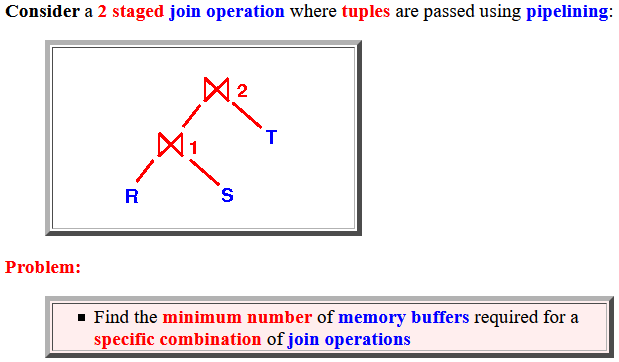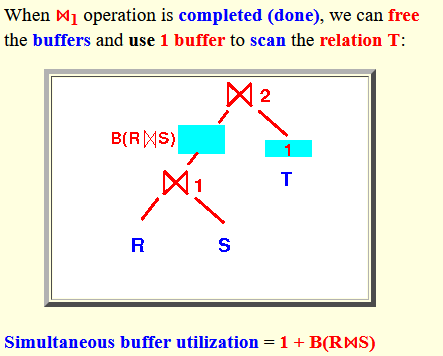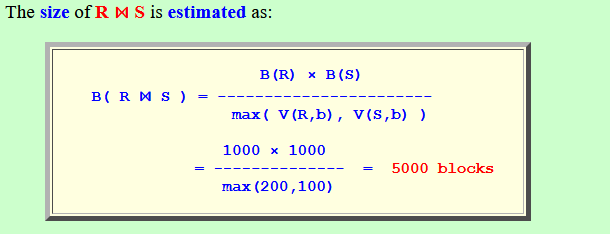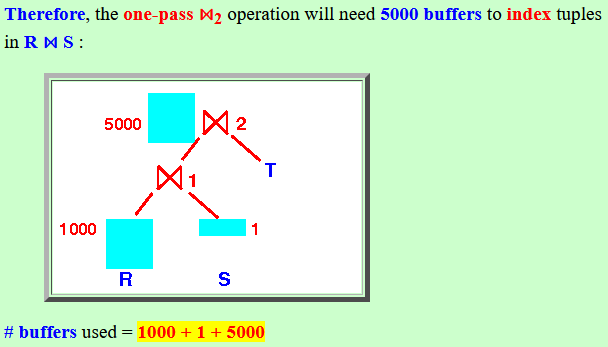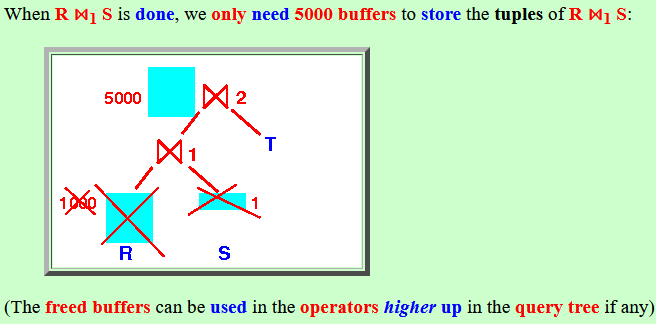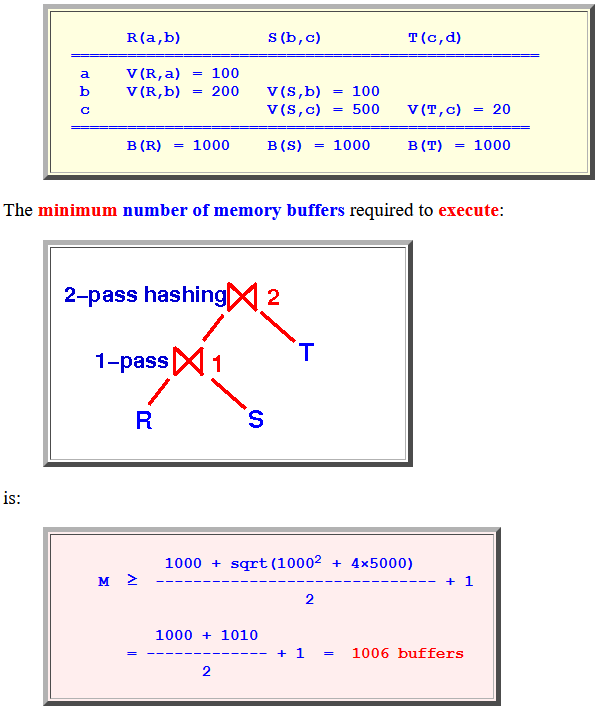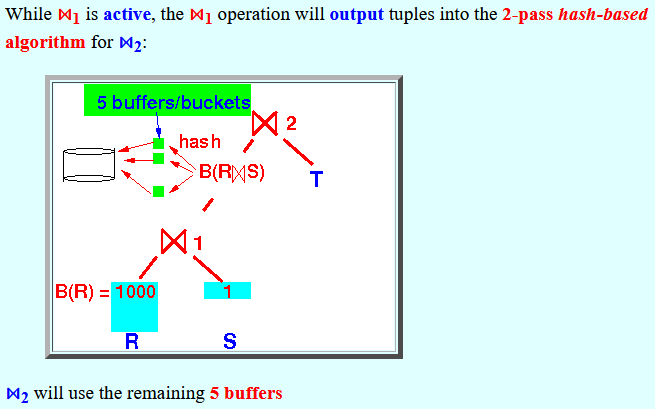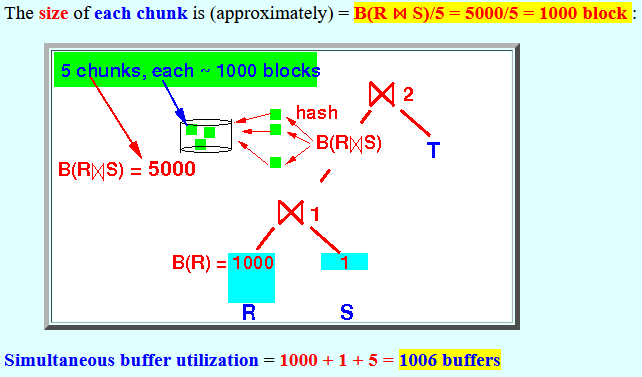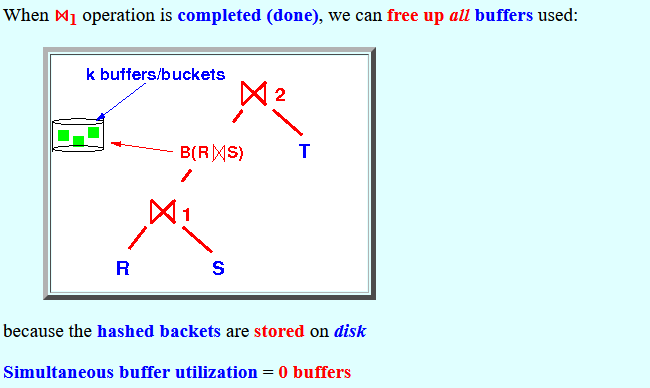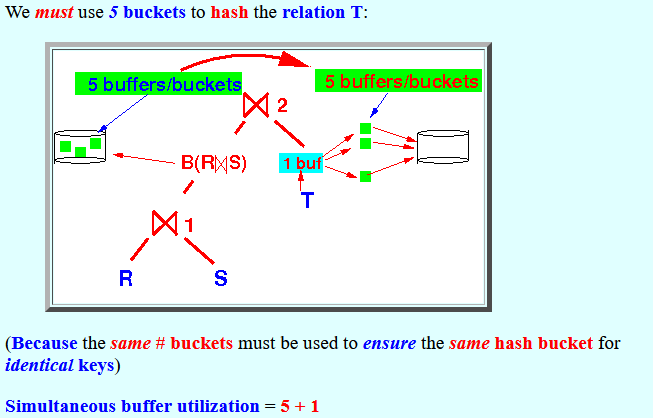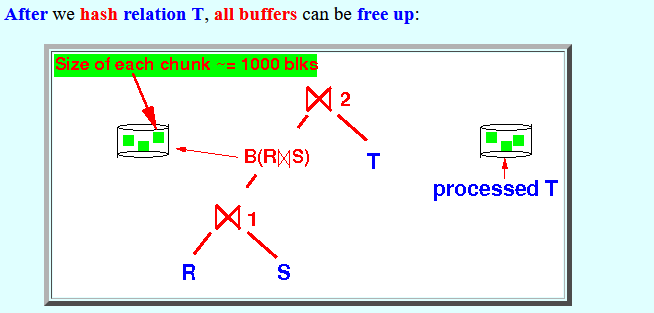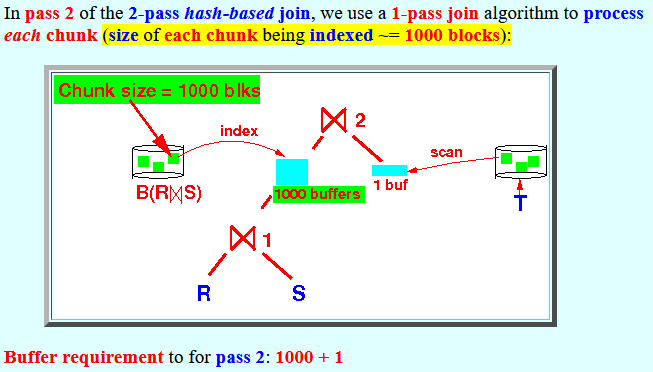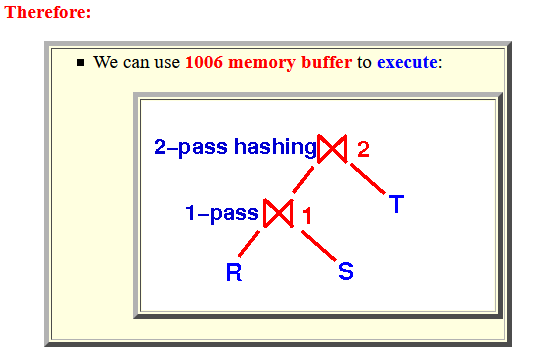Slideshow:
- Consider a
2 staged
join operation where
tuples are
passed using pipelining:
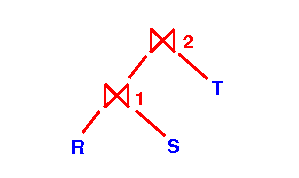
Problem:
- Find the minimum number of memory buffers required for a specific combination of join operations
- Find the
minimum
buffer requirement for
the pipelined execution:
- ⋈1 =
1-pass algorithm ---
assuming that
B(R) ≤ B(S)
(B(R) ≤ B(S) is guaranteed after we perform the optimization on the logical query plan)
- The one-pass
⋈1
will:
- Index all tuples from the first relation and
- Use 1 buffer to scan the second relation
Buffer utilization:
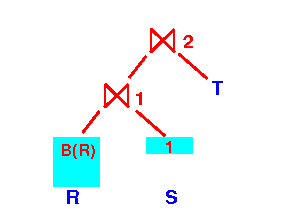
Buffer utilization so far = B(R) + 1
- While ⋈1 is
active, the
⋈1 operation will
output
tuples that will be
indexed
by the
1-pass algorithm
⋈2:
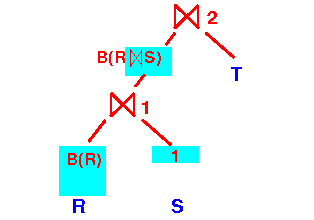
Buffer utilization = B(R) + 1 + B(R⋈S)
- When ⋈1 operation
is completed (done),
we can
free the
buffers and
use
1 buffer to
scan the
relation T:
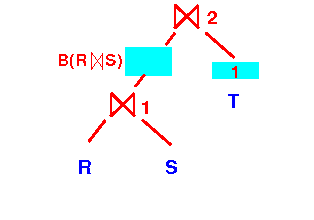
Simultaneous buffer utilization = 1 + B(R⋈S)
Conclusion:
- Minumum
buffer requirement (M)
≥
B(R) + 1 + B(R⋈S)
(= the highest buffer utilization during the entire process)
- The one-pass
⋈1
will:
- ⋈1 =
1-pass algorithm ---
assuming that
B(R) ≤ B(S)
- Example:
R(a,b) S(b,c) T(c,d) ================================================== a V(R,a) = 100 b V(R,b) = 200 V(S,b) = 100 c V(S,c) = 500 V(T,c) = 20 ================================================= B(R) = 1000 B(S) = 1000 B(T) = 1000The minimum # buffers needed to execute the following pipelined join operation:

is computed as follows:
- R ⋈1 S will
index
R with
1000 buffers and
use 1 buffer to
scan S:

# buffers used = B(R) + 1 = 1000 + 1 = 1001
- The size of
R ⋈ S is
estimated as:
B(R) × B(S) B( R ⋈ S ) = ----------------------- max( V(R,b), V(S,b) ) 1000 × 1000 = -------------- = 5000 blocks max(200,100)Therefore, the one-pass ⋈2 operation will need 5000 buffers to index tuples in R ⋈ S :
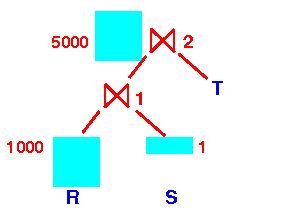
# buffers used = 1000 + 1 + 5000
- When R ⋈1 S is
done,
we only
need
5000 buffers to
store
the tuples of
R ⋈1 S:
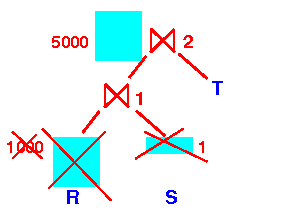
(The freed buffers can be used in the operators higher up in the query tree if any)
- Maximum
buffer requirement:
M ≥ 1000 + 1 + 5000 = 6001
- R ⋈1 S will
index
R with
1000 buffers and
use 1 buffer to
scan S:
- The minimum
buffer requirement for
the pipelined execution of:
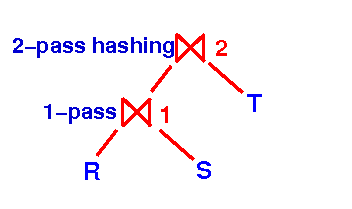
where:
- ⋈1 = 1-pass algorithm
- ⋈2 = 2-pass hashing-based algorithm
is:
B(R) + sqrt( B(R)2 + 4 B(R⋈S) ) M ≥ ---------------------------------- + 1 2
- Example:
R(a,b) S(b,c) T(c,d) ================================================== a V(R,a) = 100 b V(R,b) = 200 V(S,b) = 100 c V(S,c) = 500 V(T,c) = 20 ================================================= B(R) = 1000 B(S) = 1000 B(T) = 1000The minimum number of memory buffers required to execute:

is:
1000 + sqrt(10002 + 4×5000) M ≥ ------------------------------ + 1 2 1000 + 1010 = ------------- + 1 = 1006 buffers 2How to execute the query using 1006 buffers:
- The one-pass
⋈1
will:
- Index all tuples from the first relation and
- Use 1 buffer to scan the second relation
Buffer utilization:
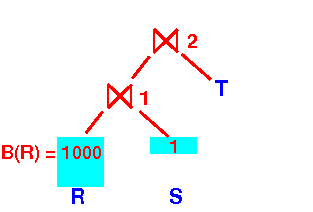
Buffer utilization so far = 1000 + 1 = 1001 buffers
- While ⋈1 is
active, the
⋈1 operation will
output
tuples into the
2-pass hash-based algorithm for
⋈2:
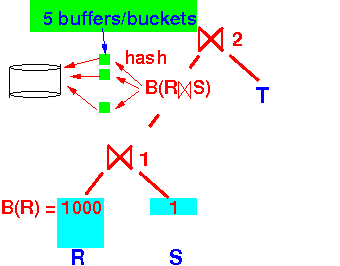
⋈2 will use the remaining 5 buffers
The size of each chunk is (approximately) = B(R ⋈ S)/5 = 5000/5 = 1000 block :
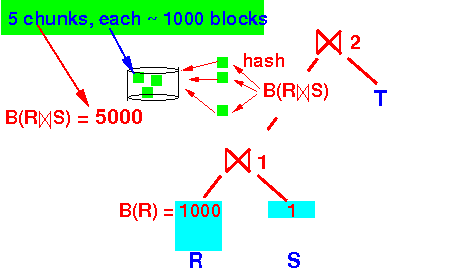
Simultaneous buffer utilization = 1000 + 1 + 5 = 1006 buffers
- When ⋈1 operation
is completed (done),
we can
free up
all
buffers used:
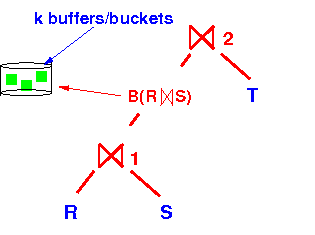
because the hashed backets are stored on disk
Simultaneous buffer utilization = 0 buffers
- We must use
5 buckets to
hash
the relation T:
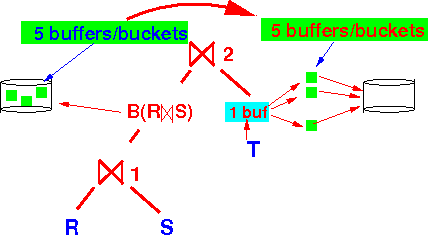
(Because the same # buckets must be used to ensure the same hash bucket for identical keys)
Simultaneous buffer utilization = 5 + 1
- After
we hash
relation T,
all buffers can be
free up:

- In pass 2 of the
2-pass hash-based join,
we use a 1-pass join algorithm
to
process
each chunk
(size of
each chunk being
indexed ~=
1000 blocks):
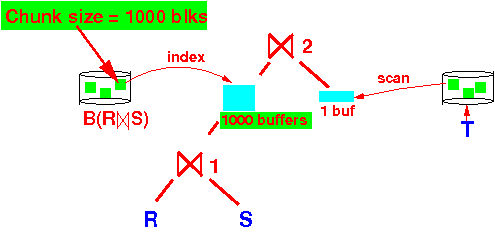
Buffer requirement to for pass 2: 1000 + 1
Therefore:
- We can use 1006 memory buffer
to execute:

(The general formula will be a homework question)
- The one-pass
⋈1
will:
- We saw an 2 examples on
how to determine:
- Given
a physical query plan
where ⋈1 and
⋈2
uses a given
implementating algorithms:

Problem:
- Determine the smallest number of buffers needed to execute the physical query plan
Fact:
- This is not the
type of questions
that is solved when
we try to
find the
best physical query plan !!!
- Finding the best physical query plan is an adequacy problem, and not a minimalization problem....
- Given
a physical query plan
where ⋈1 and
⋈2
uses a given
implementating algorithms:
- Finding the
best physical query plan:
- Given a
logical query plan
where ⋈1 and
⋈2
do not have an assigned
implementating algorithms
and M buffers:
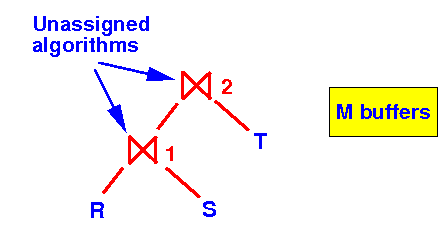
Problem:
- Determine the
"best" algorithms for
⋈1 and
⋈2
The "best" algorithms have the smallest # disk IOs that uses ≤ M buffers
- Determine the
"best" algorithms for
⋈1 and
⋈2
- Given a
logical query plan
where ⋈1 and
⋈2
do not have an assigned
implementating algorithms
and M buffers:
